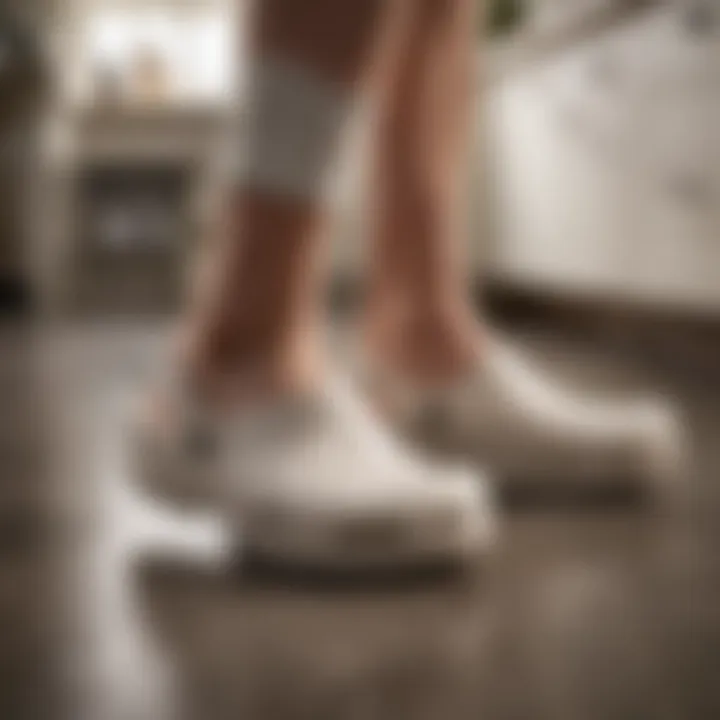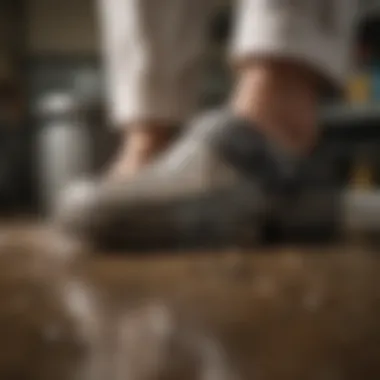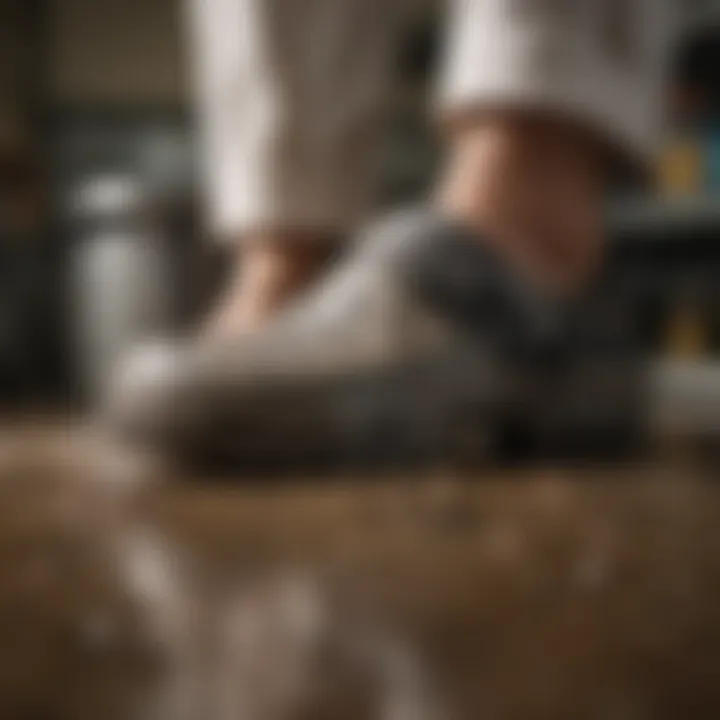Non-Slip Crocs for Chefs: Safety and Style Combined


Intro
When it comes to the bustling world of culinary arts, kitchens can be downright chaotic. Every chef knows that safety shouldn’t take a back seat when crafting beautiful dishes. Enter non-slip Crocs—not just a trend, but a game changer in many kitchens worldwide. Chefs, line cooks, and kitchen staff face a constant challenge of staying on their feet, often amidst splashes, spills, and the demands of a high-pressure environment. This guide aims to illuminate the practicality and advantages of wearing non-slip Crocs while dishing up essential insights into styles, features, and maintenance tips.
Why Crocs, you might ask? The answer lies in their thoughtful design tailored specifically for culinary professionals, combining comfort with functionality. Imagine maneuvering through a busy fridge or carrying a heavy pot without worrying about slipping. With non-slip Crocs, that worry evaporates like steam rising from a pot of boiling water. They not only provide grip but also comfort during those long shifts where every hour matters.
In this exploration, we will delve deeper into how these shoes enhance safety and comfort in the kitchen, the various styles available for different preferences, and, importantly, how to maintain them to keep them in tip-top shape. Along the way, we’ll weave in thoughts from chefs themselves on the trending style choices that merge practicality with culinary chicness. So, let’s dive in and see what makes these non-slip Crocs something worth considering for your next kitchen adventure.
Understanding Non-Slip Footwear
Footwear plays a pivotal role in any workplace, but its significance amplifies in a bustling kitchen environment. Non-slip footwear, particularly, is a necessity for chefs who navigate a world of grease, spills, and the constant movement of bustling staff. When one considers the high stakes of a culinary career, ensuring safety cannot be overstated.
In the heart of the kitchen, where fast-paced actions meet potential hazards, slipping can lead to serious injuries—not just for the chef but also for those nearby. Wearing the right non-slip shoes can mitigate these risks significantly. This is not just about personal safety; it's about maintaining a productive work atmosphere where focus remains on crafting culinary masterpieces instead of worrying about a sudden fall. Therefore, understanding and choosing the right non-slip footwear is not a trivial matter.
There are several key elements to consider regarding non-slip footwear:
- Grip and Traction: The design and materials that provide grip can drastically reduce the chances of slips. Footwear with effective traction is engineered to handle various floor surfaces, especially tile or linoleum common in kitchens.
- Comfort and Fit: Long shifts can take a toll on the feet. Proper fit and comfort directly affect a chef’s performance—nobody wants to distract themselves with sore feet while only a few feet away is a bubbling pot.
- Durability and Protection: Kitchens expose footwear to a multitude of elements, from heat to sharp objects. Non-slip shoes often come with enhanced protection that accounts for such exposure.
By diving into the specifics of non-slip footwear, we can appreciate the nuances that make certain styles more effective in a culinary setting. A better understanding will not only empower chefs to make informed choices but also elevate their overall work experience in the kitchen.
The Importance of Safety in the Kitchen
In a kitchen, where time can be of the essence and multitasking is often the norm, the risk for accidents escalates tremendously. A single misstep can lead to catastrophic consequences, not just for the individual but for their colleagues and patrons too. The importance of safety becomes fundamental. Chefs often rush from station to station, juggling pans, knives, and orders. A reliable pair of non-slip shoes becomes the unsung hero, providing a stable foundation in a highly dynamic environment.
According to the National Safety Council, slips and falls account for a substantial percentage of workplace injuries—especially in settings like kitchens where liquid spills are common. To mitigate this risk, it is imperative to invest in footwear that promotes stability and confidence during fast-paced, demanding routines. Furthermore, adopting such safety measures might even be mandated by workplace regulations, emphasizing the dual importance of legal compliance and health.
Humidity, heat, and potential hazards from dropped items pose constant threats, and safety should never be an afterthought. It should be a priority, steering actions toward a proactive rather than reactive stance. Chefs equipped with well-designed non-slip footwear embolden themselves, allowing creativity to flow without the anchor of worry about their footing.
Non-Slip Technology Explained
So, what exactly makes a shoe non-slip? The technology behind non-slip footwear marries design with materials that work together to elevate safety. Many brands incorporate specific tread patterns crafted to channel water and grease away from the contact surface between shoe and floor, drastically reducing the likelihood of slipping.
Some common elements found in non-slip footwear include:
- Outsoles: These soles are often made from rubber-like materials that excel at grip. Many shoes bear specific certifications that signify their qualifications for working in slick environments.
- Tread Design: The patterns on the outsole are vital. A well-constructed tread design features variances that create friction and help prevent slips. More grooves or lugs generally imply better performance against slipping hazards.
- Heel Stability: Non-slip shoes often come with a broader heel base for added stability. This design helps ensure that every foot placement feels secure.
In essence, the technology within non-slip footwear boils down to science and engineering, delivering a crucial safety feature that allows chefs to focus on their culinary art rather than their footing. These shoes are not merely practical; they're essential tools in the chef's arsenal, designed to foster creativity and productivity in an atmosphere rife with danger.
"The best shoes are the ones you forget you’re wearing. When it comes to non-slip footwear, that means they should be comfortable, durable, and work with your day-to-day needs."
Understanding these facets of non-slip technology solidifies the foundation for informed decision-making for chefs when selecting their appropriate footwear.
Crocs: A Background
In this section, we’ll peel back the layers on Crocs—an iconic name in the world of culinary footwear. Understanding the background of Crocs can give context to their widespread acceptance among chefs, revealing how function and form interact within this unique brand. Crocs represent not just a style choice, but also a critical element in a chef's work environment. Their emphasis on comfort, safety, and versatility has made them an essential part of culinary fashion.
The Origins of Crocs
Crocs originated in 2002 when they were initially designed as a boating shoe. The original model, known as the Beach, was made from a foam resin material called Croslite, which provided buoyancy and comfort. This unusual design quickly caught the eyes of the public, expanding into a broader market. As this brand gained traction, it soon moved beyond boating and leisure into a variety of sectors, including healthcare and, notably, culinary arts.
The ability to create a slip-resistant surface that could withstand spills and splashes made them appealing to chefs and kitchen staff. Not to mention, the ease of cleaning and quick-drying properties fit perfectly with the fast-paced culinary environment. In essence, Crocs evolved from a niche product into a staple in kitchens around the globe.
Crocs in Culinary Culture
Crocs have carved out a very special space in culinary culture. They aren’t just footwear; for many chefs, they symbolize comfort during long hours spent on their feet. You see them in bustling kitchens where the hustle and bustle of preparation often leads to unfortunate spills. Chefs have come to appreciate the non-slip feature that keeps them stable and safe, especially in slick environments.
"Wearing Crocs is like walking on a cloud while running a marathon; you don’t notice them until you need them the most!"
The adoption of Crocs in culinary settings can also be attributed to their colorful designs and the personalization they offer. Today, it’s common to see chefs donning their Crocs in vibrant hues or decked out with quirky pins that showcase their personality. From food truck kitchens to five-star establishments, Crocs continue to tread the line between functionality and a touch of individual flair.
As the culinary world evolves, so does the perception of Crocs within it. They have transitioned from being merely a practical option to a fashionable footwear choice, blending seamlessly into the lifestyle of chefs who embrace both their artistic and practical sides.
Overall, the trajectory of Crocs is interesting and worth noting. Through their evolution, they not only transformed how chefs think about footwear but also contributed to a culture where comfort and style can coexist, which is vital in a high-pressure kitchen setting.
Design Features of Non-Slip Crocs
When it comes to the kitchen, every single detail matters—whether it's the ingredients you use or the shoes you wear. In this context, non-slip Crocs stand out not just for their comfort but also for their thoughtful design features. These elements play a critical role in keeping chefs safe, preventing accidents, and ensuring that they can perform their duties without distraction. Understanding these features can help one appreciate the blend of functionality and style that non-slip Crocs bring to the culinary environment.


Material Composition
The material that makes up non-slip Crocs is unlike that of traditional shoes. They are mostly made from Croslite, a closed-cell resin that provides both lightweight properties and a cushioning effect. This means that even after long hours on your feet, these shoes won’t feel like lead weights. Moreover, Croslite is water-resistant, which is perfect for kitchens filled with spills. With this material, cleaning becomes someone’s easiest task; just rinse them off, and you’re good to go.
Additionally, this material is naturally odor-resistant, a feature that every kitchen worker can appreciate. It helps to keep feet fresher over time, reducing unwanted smells that could otherwise cling to fabric shoes. Some newer models even incorporate recycled materials, making them a more eco-friendly choice. This merging of comfort with sustainability highlights a growing trend in culinary footwear that caters to both chefs' needs and environmental concerns.
Grip and Traction Elements
Having a good grip is arguably one of the most crucial aspects of any kitchen shoe. Non-slip Crocs boast specially designed outsoles that utilize unique tread patterns. These patterns ensure maximum contact with the floor, effectively reducing the chances of slipping on wet surfaces, which happen often in a busy kitchen. The durability of the rubber outsole can’t be overlooked either. It withstands the rigors of heavy daily use, minimizing the wear and tear that can occur in high-stakes cooking environments.
"Slipping in the kitchen isn’t just embarrassing; it can be downright dangerous. The right shoes can mean the difference between a mishap and a smooth shift."
The traction doesn’t just stop there; the intrinsic flexibility of the material allows for a natural range of motion. As chefs move around, twisting and turning while carrying pots or reaching for ingredients, their footwear works seamlessly with their movements, reducing fatigue and preventing strains. Thus, safety and comfort become hand-in-hand benefits for every culinary professional wearing these unique shoes.
Ventilation and Comfort
Non-slip Crocs are not just about safety; comfort plays a significant role, especially for chefs spending long hours in a hot, bustling kitchen. One of their key features is the built-in ventilation ports that enhance airflow. This design keeps feet cooler, which is paramount when the heat of the kitchen ramps up.
More than just breathability, this ventilation also aids in moisture wicking. The well-structured design provides a cozy* fit that doesn't suffocate the foot while allowing sweat to evaporate, keeping the feet dry. Remember, dry feet equal non-issues like blisters and soreness.
In addition to the ventilation, some models have massage-like nubs on the footbed that provide gentle stimulation, making them feel like they are pampering your feet rather than simply supporting them. Chefs can find themselves on their feet for hours, adjusting and rushing. Having this level of comfort can mean the difference between a joyous shift and a grueling one.
By focusing on these design features, it becomes clear why non-slip Crocs serve as more than just footwear; they represent a functional investment in a chef's well-being, enhancing both their safety and comfort during intense culinary expeditions.
Styles and Varieties of Non-Slip Crocs
In the culinary world, the styles and varieties of non-slip Crocs hold significant importance. As chefs navigate slippery floors and work long hours, the footwear must not only be functional but also reflect individual taste and professionalism. The right pair can provide a balance between safety and style, ensuring that chefs can perform their duties effectively while also feeling comfortable.
Choosing the right style goes beyond mere aesthetics. It’s about finding footwear that offers the optimal blend of comfort, support, and traction. In a busy kitchen, where every second counts and accidents can happen in the blink of an eye, chefs might benefit from knowing what options are available and how these decisions can affect their daily performance.
Classic Styles for Chefs
Classic styles of Crocs are often favored for their simplicity and dependability. For many chefs, the traditional clogs represent a reliable choice that has stood the test of time. They typically feature a closed design with a back strap that ensures a snug fit. This also reduces the chance of slipping, providing a sense of security as the wearer navigates through a flurry of activities in the kitchen.
Some popular versions might include:
- Classic Clogs: These come in various colors and are known for their ease of cleaning, thanks to the waterproof material. Ideal for those moving around frequently.
- Bistro Clogs: Specifically designed for hospitality settings, these often have a more robust construction and additional slip-resistant features, making them a popular choice among chefs.
- On-The-Clock Classic Clogs: Tailored for professionals, these offer enhanced arch support and extra cushioning, which helps during long hours on foot.
Overall, the classic styles of non-slip Crocs resonate well with those who prioritize functionality without compromising style.
Trendy Designs and Limitations
While classic Crocs serve as the backbone of kitchen footwear, trendy designs are quickly gaining traction in culinary settings. These variations cater to chefs who desire to express their personal style while still adhering to safety requirements. From floral patterns to bold, colorful graphics, trendy designs allow chefs to stand out.
However, it’s crucial to point out the limitations that accompany these stylish options. Some trendy designs may not have the same level of durability or slip resistance as more traditional styles. For example:
- Fashion-Forward Patterns: While visually appealing, these might sacrifice the reliable grip that is essential in a kitchen environment.
- Limited Availability: Not all trendy designs are available in every size or color, which can frustrate chefs looking for the perfect match.
Ultimately, while wearing a unique design can give chefs a personality boost, it’s important to weigh the pros and cons before making a purchase. The blend of safety, comfort, and style remains key to choosing the right non-slip Crocs.
Benefits of Non-Slip Crocs for Chefs
When it comes to working in a fast-paced kitchen, the shoes you wear can genuinely make or break your day. Non-slip Crocs present numerous advantages, starting with their fundamental commitment to safety. This footwear is designed not just with chefs in mind but for anyone who navigates slippery surfaces. The blend of comfort and functionality makes them a prime choice for culinary professionals, where the stakes in safety are as high as the flames on the stovetop.
Enhanced Safety Measures
Safety should be the first thought that comes to mind when considering footwear in the kitchen. A chef's working environment is often bustling, with hot liquids and sharp objects. Non-slip Crocs feature a specialized tread pattern that grips kitchen floors, reducing the chances of slips and falls significantly. Imagine a hectic dinner rush, plates in one hand and a pot of sauce in the other; a sudden slip could lead to disaster. Crocs help mitigate these risks, providing a sturdy foundation where some traditional shoes might falter.
Key Features for Safety:
- Slip-Resistant Outsoles: The rubber outsoles are designed specifically to minimize slipping.
- Easy to Clean: Made from materials that wipe down easily, they reduce the chance of slippery messes.
Your peace of mind is priceless when you're focused on creating culinary masterpieces, and that’s where these non-slip shoes come into play.


Comfort During Long Shifts
Working hours can stretch into the double digits in a busy kitchen. Standing for long periods is the norm, and that can put a strain on the feet, back, and legs. Non-slip Crocs boast a lightweight construction that gives chefs the needed support without weighing them down.
The footbed is designed to cushion every step, contouring to your feet and helping ward off fatigue. You might think all shoes provide some comfort, but the unique construction of Crocs goes above and beyond, allowing for a soft yet supportive walking experience.
Benefits of Comfort Features:
- Lightweight Design: A crucial aspect in reducing tiredness during long shifts.
- EVA Foam: Offers shock-absorption that makes all the difference.
"In a demanding kitchen environment, comfort is just as critical as safety."
Accessibility and Ease of Use
Accessibility can often be overlooked in the pursuit of safety and comfort, yet it plays a pivotal role in a chef's daily routine. Non-slip Crocs are easy to slip on and off, minimizing time spent on footwear adjustments and creating a seamless transition between kitchen and dining areas.
When you’re in the heat of the moment, every second counts. These shoes can be quickly removed when heading outside for a break or when switching tasks that may require different footwear. Their adjustable straps and easy-entry design make them a practical choice, especially for chefs who need to act swiftly without getting bogged down by their shoes.
Advantages of Accessibility:
- Quick On/Off: Ideal when needing to swiftly change from kitchen duty to service.
- Versatile Adjustability: Straps can be modified for fit without hassle.
In summary, non-slip Crocs for chefs blend safety, comfort, and accessibility, making them a significant player in the kitchen wardrobe. They cater to the unique requirements of culinary professionals while ensuring one can focus on what truly matters—creating delicious food.
Care and Maintenance of Non-Slip Crocs
Taking good care of your non-slip Crocs is not just about keeping them looking sharp—it’s also about ensuring their longevity and effectiveness in a bustling kitchen environment. When you work in a setting where spills and slippery surfaces are par for the course, maintaining your Crocs is key to safety and performance. A well-kept pair not only provides the grip you need but also contributes to your overall comfort during those marathon shifts.
Cleaning and maintenance practices can significantly improve the lifespan of your footwear, ensuring that they continue to perform as intended, while also saving you money in the long run. Let’s dive into what it takes to keep these culinary staples in top-notch condition.
Cleaning Protocols
Maintaining hygiene in the kitchen is paramount, and your footwear plays a big part in that. Non-slip Crocs are easy to clean, which is one of their many benefits. Here are some steps and tips to keep them spotless:
- Wipe Down Regularly: After each shift, give your Crocs a quick wipe with a damp cloth to remove any food residue or dirt. This prevents stains and helps keep odors at bay.
- Deep Cleaning: For a more thorough cleanse, fill a basin with lukewarm water and add a mild detergent. Submerge your Crocs for a few minutes, scrubbing gently with a soft brush to tackle any stubborn spots. Rinse well under running water.
- Air Dry: Avoid drying your Crocs in direct sunlight or with heat, as this could warp the material. Instead, let them air dry in a well-ventilated area.
"Regular cleaning not only maintains the aesthetic appeal of your Crocs but also contributes to your overall health in a high-paced kitchen."
An effective cleaning routine ensures your non-slip Crocs retain their slip-resistant properties, eliminating the potential for accidents caused by a build-up of grime.
Addressing Wear and Tear
Like any footwear intended for high use, non-slip Crocs can succumb to the rigors of a busy kitchen environment. Keeping an eye out for signs of wear is essential:
- Check the Soles: The tread on the soles is crucial for traction. If you notice that the tread is wearing down or becomes smooth, it's time to consider a replacement. Worn-out soles diminish the slip-resistant properties.
- Material Condition: Overview the body of the Crocs for any cracking or deformities. Flexibility is essential. If the material starts to feel rigid or is visibly damaged, it can lead to discomfort.
- Repairs: Minor scratches or scuffs can often be handled with a simple polish. However, significant damage should lead you to a decision about replacing the footwear entirely. Keeping a spare pair of non-slip Crocs can be a wise backup approach, ensuring that you’re never caught off guard.
Taking the time to care for and maintain your non-slip Crocs is a simple yet effective way to enhance your safety, comfort, and efficiency while working in the kitchen. It goes hand-in-hand with your dedication to culinary excellence.
Chef Perspectives on Wearing Crocs
In the bustling world of culinary arts, where the pace is swift and the stakes can be high, chefs often find themselves at a crossroads when it comes to footwear. The choice of shoes is not merely a matter of style but rather a critical decision that can influence safety, comfort, and overall kitchen performance. Some might wonder why it’s essential to delve into the perspectives of chefs regarding Crocs. Well, the answer lies in the continuous evolution of culinary footwear and how it impacts daily operations in the kitchen.
Chefs are seasoned professionals, spending hours on their feet, darting from one end of the kitchen to the other. In such an environment, having the right pair of shoes can mean the difference between a smooth day and a slip-up—literally. Open discussions and personal accounts from culinary experts can shed light on the usability and functionality of non-slip Crocs, reinforcing not just their popularity but also their viability in a professional kitchen setting.
Real-World Experiences
Numerous chefs have taken to sharing their real-life encounters with non-slip Crocs, providing insight into their day-to-day challenges and successes. Many of these professionals report that wearing Crocs allows them the mobility needed to navigate tight spaces without compromising safety. For instance, one chef noted that after switching to Crocs, they felt more stable on wet floors, a common occurrence in any kitchen.
Additionally, chefs appreciate the ease of cleaning these shoes. Grease splashes and food spills are part of the territory, and having footwear that is easy to wipe down and maintain has become indispensable. As one line cook described, "I can’t afford to slip while juggling multiple orders. The Crocs have my back—both literally and figuratively!"
Overall, these real-world experiences contribute to a growing sense of community among cooks who advocate for non-slip Crocs, turning a personal choice into a collective endorsement.
Culinary Trends and Footwear Choice


As culinary trends evolve, so does the concept of professional attire, including footwear. Chefs are becoming increasingly aware of how their choice in shoes can reflect personal style while serving a function. There’s a blossoming awareness of the intersection between fashion and function in kitchen wear.
With the rise in popularity of casual, comfortable attire in culinary spaces, Crocs have surged as a preferred option. They embody a relaxed yet professional aesthetic, appealing to both younger and more seasoned chefs. Nowadays, it’s not unheard of to see them alongside traditional chef whites, making a statement that comfort hits the mark just as prominently as conventionality.
Moreover, the growing significance of health and wellness in culinary practices has placed emphasis on ergonomic footwear. This trend aligns seamlessly with the attributes of non-slip Crocs, which cater to the need for both comfort and stability during long shifts. Chefs are looking for shoes that not only support their feet but also allow them to express their personality. Whether it’s through color or style, non-slip Crocs fit the bill in a way that traditional chef shoes often do not.
In summary, the perspectives of chefs on wearing Crocs reflect not just personal preference but a thoughtful consideration of safety, practicality, and emerging trends in culinary fashion. As the industry evolves, so too does the narrative surrounding what it means to be both a professional and an individual in the kitchen.
Choosing the Right Non-Slip Crocs
When navigating the bustling atmosphere of a kitchen, selecting the right footwear can make a world of difference. In the culinary realm, the right non-slip Crocs do more than just complete an outfit; they enhance safety, boost comfort, and cater to the unique needs of chefs. It’s not merely about style here; it’s about finding the perfect pair that supports you during those long hours on your feet, maneuvering through spills and hot surfaces.
Assessing Individual Needs
Every chef has distinctive requirements based on their work environment, personal aesthetics, and comfort preferences. It’s vital to take a thoughtful approach when assessing what you need in your non-slip Crocs. Here are some factors to consider:
- Type of Kitchen Environment: If you're in a high-paced restaurant kitchen, you might need a shoe that’s exceptionally durable and provides top-notch slip resistance. In contrast, a pastry chef working in a less frantic section might prioritize comfort and stylish design.
- Daily Tasks: Consider the nature of your work. Do you often find yourself standing still, or are you constantly moving around, serving plates and dicing vegetables? This will guide your choice in terms of grip and foot support.
- Foot Health: For those dealing with specific foot conditions such as plantar fasciitis, insoles or arch support can be a game changer. Think about comfort features that can mitigate strain, like cushioned footbeds or better arch contouring.
- Personal Style: While it might seem frivolous, liking how your shoes look can significantly affect your mood during grueling shift. So, choose a design that resonates with your fashion sensibility while still keeping safety as a priority.
Taking all these elements into account leads to an informed choice that ticks all the boxes, ensuring style and functionality shine together.
Sizing and Fitting Tips
Now that you have a grasp of your individual needs, let’s dive into how to select the right size and fit for your non-slip Crocs. It may seem straightforward, but it’s essential to get this right to avoid discomfort or accidents on the job.
- Measure Your Feet: Begin by measuring both feet, as one foot may be slightly larger than the other. It’s best to try on shoes later in the day because feet tend to swell; this way, you won’t end up with shoes that feel snug during peak hours.
- Check the Width: Crocs often come in various widths. Be sure to know if you require a wide-fit option or if standard sizes work for you. A proper width helps prevent slipping inside the shoe, which is crucial for maintaining traction.
- Trial and Error: If possible, visit a store to try them on or order multiple options online so you can assess fit in the comfort of your own kitchen. Walk around to get a real feel for them.
- Consider a Roomy Fit: Crocs usually offer a bit of extra room, which can be beneficial for wearing socks or giving your toes some wiggle space, but ensure they're not so loose that they slide around; that could lead to accidents.
- Don’t Skimp on Replacement: If you start feeling any discomfort or your Crocs show wear and tear, it might be time to re-evaluate your fit. Worn-out patterns on the sole can compromise stability, which no chef wants.
Understanding both individual needs and sizing intricacies will set you on a path to choosing the right non-slip Crocs that will keep you safe, secure, and comfortable in the heart of the culinary world.
Comparing Non-Slip Crocs to Other Footwear
When it comes to footwear in the whirlwind world of culinary arts, safety, comfort, and style often play the three-card monte game. Chefs are on their feet almost all day, darting here and there in a sometimes chaotic milieu. Thus, the type of shoes they choose can make a world of difference. Comparing non-slip Crocs to other traditional chef shoes is not merely a matter of preference; it’s an essential evaluation of what keeps culinary professionals safe and effective in their laborious environments.
Crocs versus Traditional Chef Shoes
In the kitchen, slipping and tripping can lead to injuries that are anything but appetizing. This is where non-slip Crocs shine. These shoes are specifically designed with the kitchen in mind. Their unique outsole—often made from a proprietary material—offers grip that can stand up to grease and water, providing stability even on slick tiles. On the other hand, traditional chef shoes sometimes lack this aggressive traction, focusing instead on a more formal appearance. While they may look sharp, they can neglect the functional needs of a chef under pressure.
- Comfort: Non-slip Crocs generally feature cushioned footbeds that pamper the feet during long shifts, while many traditional shoes may feel stiffer and less forgiving over hours of wear.
- Weight: Crocs tend to be lighter than most chef shoes. When you're chasing the clock during a busy dinner service, dragging around heavier footwear is about as appealing as a soggy soufflé.
- Breathability: Crocs often include ventilation ports, aiding airflow and reducing foot sweat. This is a crucial benefit in hot kitchen environments, a feature less common in traditional chef footwear.
"The right shoes can make or break a chef’s experience in the kitchen; it’s not just about style, it’s about surviving the shift."
Price Points and Value Analysis
Chefs, like most professionals, keep a keen eye on their expenses. Crocs typically fall into a mid-range price bracket, providing affordable options without sacrificing the essentials of safety and comfort. Traditional chef shoes can vary wildly in price, often with the higher-end pairs providing additional features. Yet, the question that lingers is whether the price leap genuinely translates to performance in a high-stakes environment.
- Initial Investment: Crocs are often more accessible, asking for a relatively small chunk of cash upfront. When budget constraints are tight, this appealing aspect can’t be overlooked.
- Longevity: However, it’s crucial to consider how long the footwear can last in daily kitchen use. Many chefs find that despite a higher initial cost, traditional shoes may outlast cheaper options, reducing the frequency of purchases in the long run.
- Function versus Fashion: While some culinary experts may justify spending extra on designer or high-profile chef shoes for their looks, it’s imperative to ask whether that style serves practicality. A chic pair may turn heads in the culinary scene, yet if they lack performance features, they may not be worth their salt—or price.
In the end, the choice between non-slip Crocs and traditional chef shoes isn't black and white. Each offers a unique set of benefits that cater to different aspects of the culinary practice. Weighing cost against functionality remains a pivotal part of the decision-making process for chefs everywhere.
Future of Non-Slip Crocs in Culinary Work
The trajectory of non-slip Crocs in the culinary industry is intriguing, particularly as kitchens evolve and adapt to new demands. As chefs and kitchen staff increasingly prioritize comfort and safety—non-slip Crocs stand at the forefront of this shift. Before we delve deeper, it’s vital to recognize that footwear is not just an afterthought in the culinary world; it's a fundamental aspect that can significantly affect a chef’s performance and overall well-being.
With innovations consistently rolling out, non-slip Crocs are expected to evolve further, harmonizing style with utility. Not all kitchens are the same, and as a chef or kitchen worker, understanding the future advancements in this niche can equip one with essential insights for choosing the right footwear to tackle their unique environment. Safety is paramount, and Crocs have shown their mettle, but there is room for improvement, especially when we consider diverse work conditions and expectations.
Innovations in Design and Safety
The word on the street among culinary professionals is that Crocs are not what they used to be. Recent innovations in design are a testament to that. The cutting-edge materials now used in non-slip Crocs enhance safety, as they better withstand heat and spills, making them perfect for bustling kitchens. Improvements in traction technology have led to soles that not only grip the floor like a lion but are also flexible enough to accommodate long hours on one's feet.
- Enhanced Materials: With attention to moisture-wicking properties and easy-to-clean surfaces, the newer models require far less maintenance than their predecessors.
- Advanced Cushioning: There’s a noticeable uptick in ergonomic designs that provide support to the arches of the feet, reducing fatigue which can bloom during long shifts.
- Incorporation of Smart Features: Imagine a future where shoes react to the environment, avoiding slips before they even happen! It may sound futuristic, but early phases of smart footwear are already integrating sensors to help maintain optimal tread and grip.
"It's not just about looking good; in a high-pressure environment, it’s about ensuring every step is secure and confident."
Anticipated Trends in Culinary Footwear
The trends predicting the future of culinary footwear hint at a blend of style, functionality, and environmental consciousness. Non-slip Crocs are already a staple among many cooks, but what's coming next?
- Sustainability Focus: With more brands opting for sustainable materials, consumers are likely to see Crocs promoting eco-friendly options that resonate with the rising consciousness about environmental impact.
- Fashion Collaborations: Designers are beginning to see the potential in functional footwear, and culinary Crocs are becoming a canvas for collaborations aimed at giving the traditional designs a stylish flair that doesn't compromise safety.
- Customization Ability: Personalizing your pair of non-slip Crocs could become a trend where kitchen staff can express their individuality even in a professional setting.
Looking ahead, it’s not just enough to find a pair that won't slip. Chefs will be able to have it all—safety, sustainability, and a touch of flair that stands out in the kitchen. With these anticipated shifts, non-slip Crocs might just revolutionize not only kitchen safety but also culinary fashion at large.







